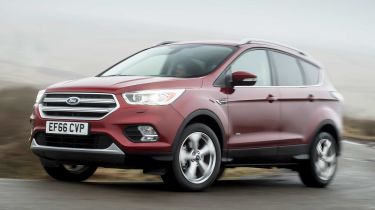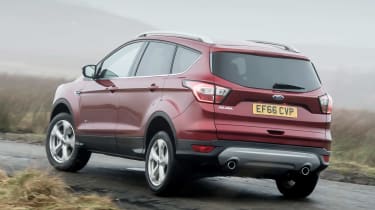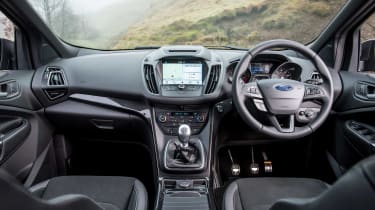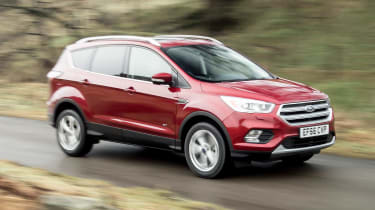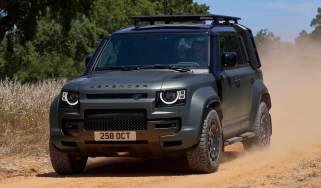New Ford Kuga 2017 review
We hit British roads to see whether a refresh has brought the Ford Kuga SUV back into contention

Ford’s changes to the Kuga for 2017 aren’t groundbreaking, but they give the SUV a welcome boost. It’s still good to drive, spacious and comfortable, although a number of rivals have caught up in all these key areas. They also have a better-quality feel and more space, as the Kuga is let down by its average cabin and small boot.
The problem with selling a car in a popular market segment is that you can struggle to get noticed. The Ford Kuga, for example, only had a handful of competitors when the first-generation model rolled off the line in 2008. But fast forward nine years, and virtually every mainstream car maker has a profitable mid-size SUV ready to poach Ford’s sizeable market share.
• Best crossovers on sale right now
Our favourite SUVs in this class, such as the slightly smaller SEAT Ateca and Peugeot 3008, have pushed the Kuga down the pecking order. Even the outgoing Mazda CX-5 could show the Ford a fresh set of heels, with its punchy diesel engine.
But a facelift can really make a difference – which is why the company has given the Kuga a similar front grille to the bigger Edge, plus restyled lights front and rear, and a reshaped tailgate. The nip and tuck freshens up the design, although we still don’t think it’s as imposing or attractive as its funkier and more youthful rivals.
More reviews
Car group tests
- Hyundai Tucson vs Ford Kuga vs Vauxhall Grandland: which is the ultimate hybrid family SUV?
- Ford Kuga vs Vauxhall Grandland: a mid-size SUV skirmish
- Ford Kuga vs Toyota RAV4 vs Skoda Karoq
In-depth reviews
Road tests
- New Ford Kuga facelift 2024 review: sensible SUV gets a bold new face
- Ford Kuga 2.5 Hybrid ST-Line X Edition 2021 review
- New Ford Kuga PHEV 2020 review
Used car tests
Inside, the changes are more limited. Ford has thrown out the low-res screen and mass of fiddly buttons for the old infotainment system and fitted its latest SYNC 3 set-up. It’s largely intuitive to operate and only occasionally does it fail to respond to your inputs. It’s just a bit odd that the company has recessed the screen into the dash rather than bringing it out at an angle, because this makes the large menu buttons tricky to reach on the move.
Cabin quality is a mixed bag, too. There’s a decent amount of soft-touch materials on the dashboard and doors, plus Ford’s trademark squidgy steering wheel. But the revised centre console, which houses the new electronic parking brake, features hard and flimsy-feeling glossy plastic.
The hard surround for the infotainment system also looks cheap, while the tiny display for the climate control is difficult to read and really dated. A Volkswagen Tiguan is well ahead in terms of perceived quality, but even a Renault Kadjar has the Kuga licked for design and fit and finish inside.
There’s plenty of space for rear-seat occupants, but disappointingly the 456-litre boot is smaller than the Ateca’s, despite the Kuga being a longer car. There’s a decent level of kit, though, with Titanium cars getting SYNC 3 (with voice control, plus Apple CarPlay and Android Auto), part-leather seats, ambient lighting, keyless go, auto braking and rear cross-traffic alert.
Ford hasn’t just focused on the bits you can see, however. There’s a couple of new engines (although the 2.0 TDCi in our car is unchanged), while new torque vectoring technology has been introduced in a bid to boost traction and stability. The suspension is unchanged, however.
Like most torque vectoring systems on mainstream cars, you’ll only notice the effect if you drive the new model back-to-back with the old one, but either way, it’s clear the Kuga is still one of the class’s better drivers’ cars. Body control is pretty good for a small SUV, while the controls are well weighted.
The Kuga has been set up for comfort, so the ride is smooth and well damped at speed, yet there’s some jiggling around town. It’s no worse than in most rivals, however. Our flagship 2.0 TDCi 180 diesel feels a lot stronger in the Kuga than it does in the heavier Edge, while it’s flexible and refined even on the motorway. Claimed fuel economy of 54.3mpg is largely competitive for the class, especially since our car has grippy four-wheel drive. Unfortunately, this engine isn’t available as a cheaper and more frugal front-wheel-drive variant.
The £28,545 price of this model might appear steep at first, but it’s roughly in line with rivals, while Ford dealers are likely to offer generous monthly payment deals.
